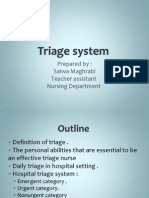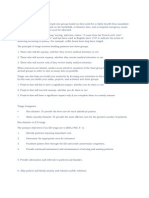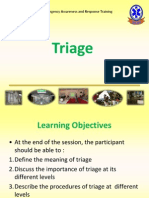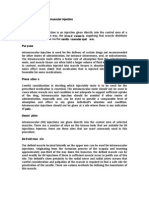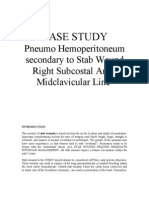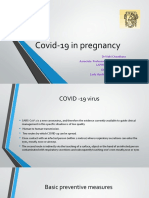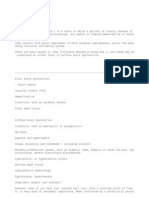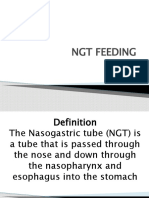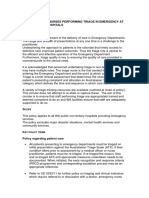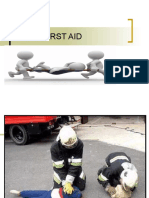Triage Is The Process of Determining The Priority of Patients' Treatments Based On The Severity of
Triage Is The Process of Determining The Priority of Patients' Treatments Based On The Severity of
Uploaded by
Ralph PelegrinoCopyright:
Available Formats
Triage Is The Process of Determining The Priority of Patients' Treatments Based On The Severity of
Triage Is The Process of Determining The Priority of Patients' Treatments Based On The Severity of
Uploaded by
Ralph PelegrinoOriginal Description:
Original Title
Copyright
Available Formats
Share this document
Did you find this document useful?
Is this content inappropriate?
Copyright:
Available Formats
Triage Is The Process of Determining The Priority of Patients' Treatments Based On The Severity of
Triage Is The Process of Determining The Priority of Patients' Treatments Based On The Severity of
Uploaded by
Ralph PelegrinoCopyright:
Available Formats
Triage is the process of determining the priority of patients' treatments based on the severity of their condition.
Triage is used in a number of situations including: In mass casualty situations, triage is used to decide who is most urgently in need of transportation to a hospital for care (generally, those who have a chance of survival but who would die without immediate treatment) and whose injuries are less severe and must wait for medical care. Triage is also commonly used in crowded emergency rooms and walk-in clinics to determine which patients should be seen and treated immediately. Triage may be used to prioritize the use of space or equipment, such as operating rooms, in a crowded medical facility. Triage may also be used for patients arriving at the emergency department, or telephoning medical advice systems, among others. This article deals with the concept of triage as it occurs in medical emergencies, including the prehospital setting, disasters, and emergency room treatment. The term triage may have originated during the Napoleonic Wars from the work of Dominique Jean Larrey. The term was used further during World War I by French doctors treating the battlefield wounded at the aid stations behind the front. Those responsible for the removal of the wounded from a battlefield or their care afterwards would divide the victims into three categories: Those who are likely to live, regardless of what care they receive; Those who are likely to die, regardless of what care they receive;
Those for whom immediate care might make a positive difference in outcome.
In emergency department, an interview with a triage nurse is a common first step to receiving care. He or she generally takes a brief medical history of the complaint and measures vital signs in order to identify seriously ill persons who must receive immediate care.
TYPES OF TRIAGE 1. Simple Triage Simple triage is usually used in a scene of an accident or "mass-casualty incident" (MCI), in order to sort patients into those who need critical attention and immediate transport to the hospital and those with less serious injuries. This step can be started before transportation becomes available. Upon completion of the initial assessment by medical or paramedical personnel, each patient may be labelled which may identify the patient, display assessment findings, and identify the priority of the patient's need for medical treatment and transport from the emergency scene. At its most primitive, patients may be simply marked with coloured flagging tape or with marker pens. Pre-printed cards for this purpose are known as a triage tag. 2. Advance Triage In advanced triage, doctors and specially trained nurses may decide that some seriously injured people should not receive advanced care because they are unlikely to survive. It is used to divert scarce resources away from patients with little chance of survival in order to increase the chances of survival of others who are more likely to survive. The use of advanced triage may
become necessary when medical professionals decide that the medical resources available are not sufficient to treat all the people who need help. The treatment being prioritized can include the time spent on medical care, or drugs or other limited resources. 3. Continuous integrated triage Continuous integrated triage is an approach to triage in mass casualty situations which is both efficient and sensitive to psychosocial and disaster behavioral health issues that affect the number of patients seeking care (surge), the manner in which a hospital or healthcare facility deals with that surge (surge capacity) and the overarching medical needs of the event. Continuous integrated triage combines three forms of triage with progressive specificity to most rapidly identify those patients in greatest need of care while balancing the needs of the individual patients against the available resources and the needs of other patients. Continuous integrated triage employs: Group (Global) Triage Physiologic (Individual) Triage Hospital Triage
4. Reverse Triage In addition to the standard practices of triage as mentioned above, there are conditions where sometimes the less wounded are treated in preference to the more severely wounded. This may arise in a situation such as war where the military setting may require soldiers be returned to combat as quickly as possible, or disaster situations where medical resources are limited in order
to conserve resources for those likely to survive but requiring advanced medical care.[15] Other possible scenarios where this could arise include situations where significant numbers of medical personnel are among the affected patients where it may be advantageous to ensure that they survive to continue providing care in the coming days especially if medical resources are already stretched. In cold water drowning incidents, it is common to use reverse triage because drowning victims in cold water can survive longer than in warm water if given immediate basic life support and often those who are rescued and able to breathe on their own will improve with minimal or no help. 5. Undertriage and Overtriage Undertriage is the underestimating the severity of an illness or injury. An example of this would be categorizing a Priority 1 (Immediate) patient as a Priority 2 (Delayed) or Priority 3 (Minimal). Historically, acceptable undertriage rates have been deemed 5% or less. Overtriage is the overestimating of the severity of an illness or injury. An example of this would be categorizing a Priority 3 (Minimal) patient as a Priority 2 (Delayed) or Priority 1 (Immediate). Acceptable overtriage rates have been typically up to 50% in an effort to avoid undertriage. Some studies suggest that overtriage is less likely to occur when triaging is performed by hospital medical teams, rather than paramedics or EMTs. 6. Secondary (in-hospital) triage In advanced triage systems, secondary triage is typically implemented by emergency nurses, skilled paramedics, or battlefield medical personnel within the emergency departments of hospitals during disasters, injured people
7. S.T.A.R.T. model S.T.A.R.T. (Simple Triage and Rapid Treatment) is a simple triage system that can be performed by lightly trained lay and emergency personnel in emergencies.[22] It is not intended to supersede or instruct medical personnel or techniques. It has been taught to California emergency workers for use in earthquakes. It was developed at Hoag Hospital in Newport Beach, California for use by emergency services. It has been field-proven in mass casualty incidents such as train wrecks and bus accidents, though it was developed for use by community emergency response teams (CERTs) and firefighters after earthquakes. CATEGORIES RED Immediately: Priority One (Life-Threatening Conditions) The condition is life-threatening and the patient requires immediate attention and transport. The following conditions should be present for a Mass Casualty Incident (MCI) victim to be classified Priority One: Obstruction or damage to airway Disturbance of breathing Disturbance in circulation Does not follow command or altered level of consciousness Need for life
Victims who injuries demand definitive treatment in the hospital but which treatment may be delayed without prejudice to ultimate recovery
YELLOW Urgent: Priority Two Patient has passed primary survey but with major system injury, may delay transport to one hour. Any one of the following conditions could place a victim in to Priority Two category: Needs to be treated within one hour, otherwise they become unstable Severe burns involving hands, feet or face (not including the respiratory tract; burns complicated by major soft tissue trauma Hospital admission is required Moderate blood loss, back injuries, head injuries with a normal level of consciousness
GREEN Delayed: Priority Three An injury exists but treatment can be delayed for four to six hours. Generally, anyone who can walk (walking wounded) to a designated area for treatment will be a Priority Three. The following injuries are examples: Minor injuries not threatened by airway, breathing and circulatory instability Minor fractures, minor soft tissue injuries, minor burns May or may not be admitted
BLUE Near Dead: Priority Four
Victims who are clinically dead. Those tagged blue in the field are to be returned for retriaging when time and physical conditions of area allow. BLACK and WHITE Dead: Last Priority Patient is dead Those who die while awaiting treatment and those in cardiac arrest following trauma.
You might also like
- 50133966892Document2 pages50133966892pchipanzhyaNo ratings yet
- Jim Nursing Essay - Chronic Obstructive Pulmonary Disease (COPD) .Document8 pagesJim Nursing Essay - Chronic Obstructive Pulmonary Disease (COPD) .SarahJaneNo ratings yet
- CVC 302 ManualDocument176 pagesCVC 302 ManualMazda62006100% (5)
- Little Schmidy Falls Risk AssessmentDocument1 pageLittle Schmidy Falls Risk AssessmentrenystrawberryNo ratings yet
- Prepared By: Salwa Maghrabi Teacher Assistant Nursing DepartmentDocument18 pagesPrepared By: Salwa Maghrabi Teacher Assistant Nursing DepartmentRavi Sankar Venkatesan100% (3)
- Seeking The Sacred in Contemporary Religious ArchitectureDocument104 pagesSeeking The Sacred in Contemporary Religious ArchitectureMuhammad Atif UsmaniNo ratings yet
- Manu Kant: Executive SummaryDocument6 pagesManu Kant: Executive SummarymanukleoNo ratings yet
- Medical Triage: Code Tags and Triage TerminologyDocument3 pagesMedical Triage: Code Tags and Triage TerminologyAnieaj Buj LevineNo ratings yet
- TriageDocument5 pagesTriageReZwin D'zirhteyagz0% (1)
- TriageDocument8 pagesTriagekristina_zamoraNo ratings yet
- TriageDocument9 pagesTriageSaid El-AwourNo ratings yet
- The COAT & Review Approach: How to recognise and manage unwell patientsFrom EverandThe COAT & Review Approach: How to recognise and manage unwell patientsRating: 5 out of 5 stars5/5 (1)
- The 10 Rights of Medications AdministrationDocument2 pagesThe 10 Rights of Medications AdministrationSistine Rose LabajoNo ratings yet
- Critical Care Nursing (NCM 410) Notes 1Document66 pagesCritical Care Nursing (NCM 410) Notes 1Danielle OnaNo ratings yet
- Triage: Hospital Emergency Awareness and Response TrainingDocument34 pagesTriage: Hospital Emergency Awareness and Response TrainingrgiemorenoNo ratings yet
- De La Salle Lipa: Nursing Care Management 114 GeriatricsDocument3 pagesDe La Salle Lipa: Nursing Care Management 114 GeriatricsGaea AngelaNo ratings yet
- Simple Triage and Rapid TreatmentDocument9 pagesSimple Triage and Rapid TreatmentGung IndrayanaNo ratings yet
- Role of Nursing in ICUDocument47 pagesRole of Nursing in ICUsasmita nayakNo ratings yet
- Endotracheal IntubationDocument5 pagesEndotracheal Intubationpriyanka bhavsarNo ratings yet
- Vitamin K Administration in The Newborn GuidelineDocument10 pagesVitamin K Administration in The Newborn GuidelineAna Sarah KurniaNo ratings yet
- Total Abdominal Hysterectomy Bilateral SaphingoDocument7 pagesTotal Abdominal Hysterectomy Bilateral SaphingoAndrea BroccoliNo ratings yet
- Perioperative NursingDocument13 pagesPerioperative NursingTobiDaNo ratings yet
- Administering Intramuscular InjectionDocument11 pagesAdministering Intramuscular Injectionbwester2222No ratings yet
- Case Study StabDocument7 pagesCase Study StabMari Jasmeen Estrada Noveda100% (1)
- Covid in PregnancyDocument30 pagesCovid in Pregnancyvidhi chaudharyNo ratings yet
- Infection Control Protocols at Travancore Medical College HospitalDocument8 pagesInfection Control Protocols at Travancore Medical College Hospitaltummalapalli venkateswara raoNo ratings yet
- TRIAGE Skills LabDocument8 pagesTRIAGE Skills Labczeremar chanNo ratings yet
- Cappilary Blood Glucose Monitoring ChecklistDocument2 pagesCappilary Blood Glucose Monitoring ChecklistRenz Kier Lorenzo ComaNo ratings yet
- NCLEX Midterm HandoutDocument17 pagesNCLEX Midterm Handoutjomel magalonaNo ratings yet
- OxygenationDocument12 pagesOxygenationCherry Lou Guanzing100% (1)
- The Medical Surgical NurseDocument2 pagesThe Medical Surgical Nurseroonn100% (3)
- Care of Unconscious PatientDocument6 pagesCare of Unconscious PatientSuparna SinghaNo ratings yet
- Introduction To Perioperative NursingDocument19 pagesIntroduction To Perioperative NursingaidaelgamilNo ratings yet
- Chapter 20 Admission, Transfer, and DischargeDocument4 pagesChapter 20 Admission, Transfer, and DischargetvrossyNo ratings yet
- Health Teaching Plan General Objectives: After One Hour of Nurse-Patient Interaction, The Patient Will Be Able To Acquire Knowledge, Skills and Attitude RegardingDocument3 pagesHealth Teaching Plan General Objectives: After One Hour of Nurse-Patient Interaction, The Patient Will Be Able To Acquire Knowledge, Skills and Attitude RegardingJAMES PATRICK MONTEMAYORNo ratings yet
- About Clinical Instructors Evaluating Nursing StudentsDocument22 pagesAbout Clinical Instructors Evaluating Nursing Studentsrex_tubana50% (2)
- A Case of Cervical CancerDocument24 pagesA Case of Cervical CancerDebbie beeNo ratings yet
- Challenges of Being A Critical Care NurseDocument14 pagesChallenges of Being A Critical Care NurseKatie PurryNo ratings yet
- Assignment 1 Health AssessmentDocument8 pagesAssignment 1 Health AssessmentHung PhanNo ratings yet
- SmallpoxDocument3 pagesSmallpoxKailash NagarNo ratings yet
- Nursing ProceduresDocument51 pagesNursing ProceduresLouella Mae CoraldeNo ratings yet
- Management of Status Asthmatic Us in ChildrenDocument7 pagesManagement of Status Asthmatic Us in Childrenjshq1971No ratings yet
- IV Injections and InfusionsDocument2 pagesIV Injections and InfusionsFrancis Lawrence AlexanderNo ratings yet
- Peg Feeding RationaleDocument3 pagesPeg Feeding RationaleAlyzza Dagoy100% (1)
- Nursing Leadership and Management Case StudyDocument9 pagesNursing Leadership and Management Case StudyCamille GraceNo ratings yet
- Abdominal Case Study CompiledDocument392 pagesAbdominal Case Study CompiledIshak IzharNo ratings yet
- An Inspiring SPDocument3 pagesAn Inspiring SPJoemar De Pascion NovillaNo ratings yet
- Introduction Disaster NursingDocument11 pagesIntroduction Disaster NursingydtrgnNo ratings yet
- START Triage Training PresentationDocument85 pagesSTART Triage Training PresentationPandu Putra Wijaya RestaNo ratings yet
- Thyroid StormDocument3 pagesThyroid StormAnjelika Eurelle Caliboso MapiliNo ratings yet
- Week 9 10 Learning Plan in Intensive Nursing PracticeDocument7 pagesWeek 9 10 Learning Plan in Intensive Nursing PracticeSheryl Ann Barit PedinesNo ratings yet
- Nursing AuditDocument26 pagesNursing AuditJoe ShewaleNo ratings yet
- NOVEMBER 10, 2021 DAY 2 Intensive Care Unit: Critical Care TeamDocument7 pagesNOVEMBER 10, 2021 DAY 2 Intensive Care Unit: Critical Care TeamLeslie PaguioNo ratings yet
- NGT Feeding: by Group 2Document25 pagesNGT Feeding: by Group 2karl montano100% (1)
- Guidelines For Nurses Performing TriageDocument4 pagesGuidelines For Nurses Performing TriagedroenNo ratings yet
- SWOT AssignmentDocument14 pagesSWOT AssignmentNur Farzana100% (1)
- CPR & First AidDocument125 pagesCPR & First AidEvaNatashaNo ratings yet
- Critical Thinking FHP WorksheetDocument17 pagesCritical Thinking FHP WorksheetfairwoodsNo ratings yet
- Endotracheal IntubationDocument5 pagesEndotracheal IntubationDarell M. BookNo ratings yet
- A Study To Assess The Knowledge of Mothers Regarding Weaning Among Children 6 Months To 2 Years of Age in Selected Rural Areas of Punjab IndiaDocument3 pagesA Study To Assess The Knowledge of Mothers Regarding Weaning Among Children 6 Months To 2 Years of Age in Selected Rural Areas of Punjab IndiaIJARP PublicationsNo ratings yet
- Preoperative Checklist: Ilocos Sur Provincial Hospital-Gabriela SilangDocument1 pagePreoperative Checklist: Ilocos Sur Provincial Hospital-Gabriela SilangHanna La MadridNo ratings yet
- Measuring CBGDocument26 pagesMeasuring CBGChengRosaleNo ratings yet
- Ventricular Septal Defect, A Simple Guide To The Condition, Treatment And Related ConditionsFrom EverandVentricular Septal Defect, A Simple Guide To The Condition, Treatment And Related ConditionsNo ratings yet
- Damping MeasurementsDocument50 pagesDamping MeasurementsWon-young Seo100% (1)
- Assessment of Groundwater Quality and Saline Water Intrusion in The Coastal Aquifers of Purba Midnapur DistrictDocument11 pagesAssessment of Groundwater Quality and Saline Water Intrusion in The Coastal Aquifers of Purba Midnapur DistrictDhrubaNo ratings yet
- 742236V01Document2 pages742236V01David Antonio Matias VelascoNo ratings yet
- Elevation Finishes ShopdrawingsDocument4 pagesElevation Finishes ShopdrawingssaifallabristeelNo ratings yet
- CompressorsDocument34 pagesCompressorsShanza AsifNo ratings yet
- IPDC - 3160003 - PPT Topic - 2023 - 2024Document3 pagesIPDC - 3160003 - PPT Topic - 2023 - 2024JENIL PATELNo ratings yet
- Salt Removal Effect by Fine BubblesDocument4 pagesSalt Removal Effect by Fine BubblesSCR_010101No ratings yet
- Welcome To Crystal Hunters!: Japanese Writing SystemsDocument45 pagesWelcome To Crystal Hunters!: Japanese Writing SystemsbobNo ratings yet
- ACI 533 5R 20 Guide For Precast Concrete Tunnel Segments 2020Document84 pagesACI 533 5R 20 Guide For Precast Concrete Tunnel Segments 2020haddad.marianne.23No ratings yet
- Cryptography Overview: John MitchellDocument87 pagesCryptography Overview: John MitchellWIBF KevinNo ratings yet
- EIA 2004 Exam QuestionsDocument6 pagesEIA 2004 Exam QuestionsSofy AnuraNo ratings yet
- Welcome To The Pages of Maarten Maartensz. See Also: + + + + + +Document52 pagesWelcome To The Pages of Maarten Maartensz. See Also: + + + + + +conditioned_genesis1504No ratings yet
- AD2006+ Multi-Session GuideDocument21 pagesAD2006+ Multi-Session Guidejohnsspamaddress100% (1)
- B550 PG VelocitaDocument99 pagesB550 PG VelocitaEduardo RigueraNo ratings yet
- H6M-P30 (B3) / H6M-P25 (B3) / H6M-P22 (B3) Series: MS-7680 (v5.x) MainboardDocument155 pagesH6M-P30 (B3) / H6M-P25 (B3) / H6M-P22 (B3) Series: MS-7680 (v5.x) MainboardЮрій РудийNo ratings yet
- Technopreneurship 101: Value PropositionDocument27 pagesTechnopreneurship 101: Value PropositionAngel MendiolaNo ratings yet
- 1 s2.0 S1815385213000266 Main PDFDocument5 pages1 s2.0 S1815385213000266 Main PDFP NielsenNo ratings yet
- 〈Small-Signal Transistor〉: Isahaya Electronics CorporationDocument4 pages〈Small-Signal Transistor〉: Isahaya Electronics Corporationperro sNo ratings yet
- Backflush CostingDocument45 pagesBackflush CostingKIROJOHNo ratings yet
- Cummins (2002) - A Model of SWB HomeostasisDocument40 pagesCummins (2002) - A Model of SWB HomeostasisAmalia NurlinaNo ratings yet
- Babbie Ethics 5e PPT CH 3Document31 pagesBabbie Ethics 5e PPT CH 3tudorbianca7267No ratings yet
- List Most H1B Employers 2008Document475 pagesList Most H1B Employers 2008saurabhsri03No ratings yet
- Karta Pracy B2 No 2Document2 pagesKarta Pracy B2 No 2Maria GeltzNo ratings yet
- Discrete MathematicsDocument23 pagesDiscrete MathematicsccchengchuuuNo ratings yet
- Industry Day - Code 70 Slides 2.25.14Document11 pagesIndustry Day - Code 70 Slides 2.25.14N TNo ratings yet




